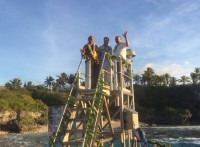New tide gauge for Niue - waves, tides, weather & sea level
06/11/2015

The communities on the south west Pacific island of Niue are celebrating the completion of a new tidal gauge and positioning infrastructure that will provide critical weather and sea level information for the country and the Pacific region.
The tide gauge was formally launched today by the Premier of Niue, the Hon. Toke Talagi; the Australian Government Minister for International Development and the Pacific, Hon. Steven Ciobo MP; and the Director-General of the Pacific Community, Dr Colin Tukuitonga, in the presence of representatives from throughout the Pacific who are in Niue for the 9th biennial Pacific Community Conference.
The three metre tall structure houses 10 separate instruments that monitor weather, tides, sea level and position. It will provide information in real time, direct to the Niue Meteorological Service and key industries like infrastructure planning, geosciences, fisheries, shipping and tourism.
The state of the art instruments will measure changes in sea level and can detect land movement to deliver information critical to managing our ocean environment and informing actions to mitigate the potential impacts of sea level changes in the Pacific.
The Director of the Niue Meteorological Service, Mr Sionetasi Pulehetoa said, "After many years of looking for a sponsor to fund the gauge, Niue is grateful to the Government of Australia for assisting us with this project. The new tide gauge will provide us with real time weather observations and tide levels and so enable us to generate monthly tidal predictions which will help us better support local maritime safety initiatives, and advise fishing and tourism operations, as well as contribute to global systems like the Pacific and Australian tsunami warning system."
The installation also collects information on land movement from global positioning satellites. These measurements play an essential role in sea-level monitoring as they are used to determine if the land is moving, the sea level is changing, or both. This will allow Niue to assess the extent and potential impact of rising sea levels so that they can effectively plan coastal infrastructure and disaster risk reduction initiatives.
Mr. Ciobo said the tidal gauge is a practical example of the resilience measures being used to support the Pacific. "Australia recognises climate change is a critical issue for our region and we are playing a key role in supporting Pacific Island countries to prepare for, and adapt to the impacts of climate change," he said.
The remote coral atoll, commonly called "The Rock", was a very challenging location for this large infrastructure project. With up to sixty metre limestone cliffs, seasonal cyclones, and powerful waves, it took years of planning and feasibility studies to select a site for the gauge, and design a structure that could withstand nature's fury.
Ms Janita Pahalad from the Australian Bureau of Meteorology's Climate and Ocean Support Program in the Pacific (COSPPac) said that, "The Niue tide gauge is the most technologically advanced of all of the 14 gauges in the Australian-funded Pacific tide gauge network. It is one of COSPPac's most significant milestones - it's been a lot of work but we're extremely proud of what this regional partnership has achieved."
One of the program's long-time partners is the Secretariat of the Pacific Community (SPC), a Pacific regional organisation providing expertise in technical areas, including geoscience and oceanography. "It's a significant development that we are finally able to add Niue to the Pacific tide gauge network," Dr Tukuitonga said. "It's going to provide information that is valuable to the whole region, not just Niue."
Managed by the Australian Bureau of Meteorology, and funded by the Australian Government's Department of Foreign Affairs and Trade, this landmark installation was possible due to the collaborative efforts of the Niue Government, private contractors, and specialist science and engineering staff from the Australian Bureau of Meteorology, Geoscience Australia, and the Secretariat of the Pacific Community.










